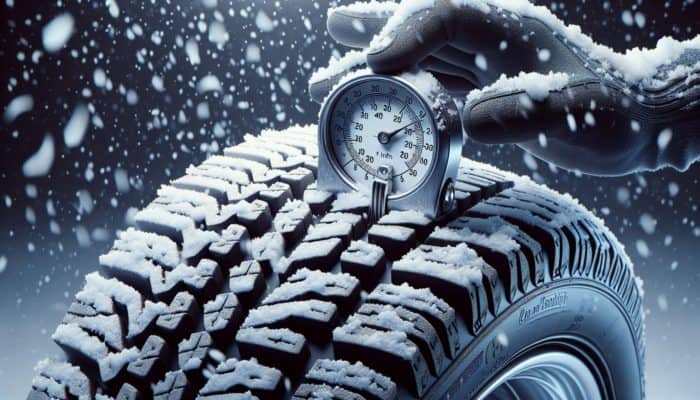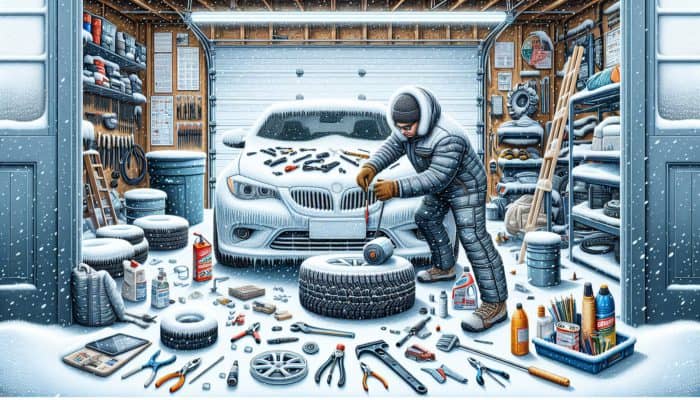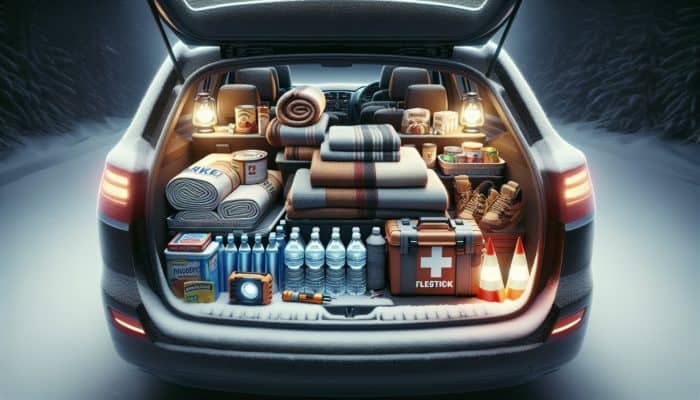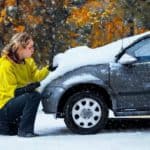Thorough Pre-Trip Vehicle Inspection for Safe Winter Travel
Assessing Tire Condition for Optimal Traction

Blizzard Vehicle Prep: The condition of your tires plays a crucial role in ensuring a secure connection between your vehicle and the road, particularly under challenging snowy conditions. Before embarking on any winter excursion, it is essential to thoroughly assess both the tread depth and air pressure of your tires. Ideally, the tread depth should measure at least 6/32 inches, as this provides the necessary grip on both snow and ice. Insufficient tread depth can compromise traction, significantly increasing the risk of accidents during winter driving.
Consistent monitoring of tire pressure is equally essential for safe driving. Cold temperatures can cause tire pressure to drop, often by approximately 1 PSI for every 10-degree Fahrenheit decrease in temperature. This reduction can adversely affect your vehicle’s handling and stopping distances, making it imperative to keep your tires inflated to the manufacturer’s recommended levels. A simple yet effective tire pressure gauge can be an invaluable tool to ensure that your tires remain capable of navigating the challenges posed by winter roads.
Alongside checking pressure and tread depth, it is crucial to inspect your tires for any visible damage, such as cracks or punctures. Any irregularities can severely undermine your safety. Seeking a professional evaluation of your tires can also provide peace of mind for your winter travels, ensuring that your vehicle is fully prepared to tackle whatever weather conditions may lie ahead.
Ensuring Battery Health for Cold Weather Performance
The battery serves as the heart of your vehicle’s electrical system, and in frigid weather, it must work harder to supply the necessary power. Cold temperatures can significantly diminish a battery’s capacity, underscoring the importance of ensuring that your battery is in peak condition and fully charged before setting out. If your battery is three years old or older, regular testing is advisable to confirm its ability to maintain a charge.
Many auto parts retailers provide complimentary battery testing, which can offer valuable insights into the battery’s performance in low temperatures. If your battery fails this test, consider replacing it with one specifically designed for cold weather conditions. When selecting a new battery, pay attention to the cold-cranking amps (CCA), as a higher CCA rating indicates superior performance in frigid conditions.
Furthermore, it is essential to examine the battery terminals for any signs of corrosion to ensure they are clean and securely connected. Loose or corroded terminals can hinder the battery’s efficiency and may lead to a no-start situation when you need your vehicle the most, particularly in harsh winter conditions.
Checking Fluid Levels for Optimal Vehicle Performance
Conducting a comprehensive inspection of your fluid levels is crucial for ensuring your vehicle operates optimally during the winter months. Please start by checking the antifreeze, verifying both its level and mixture. The ideal antifreeze-to-water ratio is typically 50/50, as this ensures effective engine cooling and prevents freezing. Low antifreeze levels can lead to overheating or potential engine damage, particularly when temperatures drop significantly.
Next, assess the oil levels. During cold weather, using the appropriate oil viscosity can make a notable difference. For instance, synthetic oil remains fluid at lower temperatures, facilitating easier starts and better engine performance.
Windshield washer fluid is often a neglected aspect of winter preparation, yet it plays a critical role in maintaining visibility during snowstorms. Replace summer fluids with winter-specific washer fluid, which contains antifreeze agents to prevent freezing. Regularly topping up these essential fluids can prevent dangerous situations on the road, ensuring you maintain full control of your vehicle even in challenging weather conditions.
Expert Winterisation Techniques for Your Vehicle

Investing in Quality Snow Tires for Enhanced Traction
Equipping your vehicle with snow tires is one of the most effective ways to ensure safety while driving during the winter months. These tires are specifically engineered with deeper treads and softer rubber compounds, providing enhanced grip and handling on icy and snowy roads. Unlike all-season tires, which may not perform optimally in severe winter conditions, snow tires significantly improve traction, enabling better control when navigating treacherous terrain.
The importance of snow tires is highlighted by various studies, which indicate that vehicles fitted with them can stop up to 30% shorter in snowy conditions compared to those equipped with standard tires. This difference can be critical, potentially determining whether you can safely navigate a corner or risk skidding into a hazardous situation.
It is advisable to switch to snow tires when temperatures consistently drop below 7 degrees Celsius (44 degrees Fahrenheit). Such proactive measures can greatly enhance your winter driving experience, ensuring that you remain safe while travelling to your destination, regardless of the weather conditions.
Verifying Heater and Defroster Functionality
A fully functional heating system and defroster are essential for maintaining a comfortable and safe driving environment throughout the winter months. Before undertaking any significant journeys, conduct a thorough check of your vehicle’s heating capabilities. Please turn on the heater to confirm that it consistently produces warm air, and ensure that the defroster effectively clears both the windshield and rear window.
Visibility is paramount when driving in snow, and a malfunctioning defroster can severely impair your ability to see the road ahead. If you identify any issues with your heating system, seek professional repairs immediately to avoid discomfort and danger while driving in cold conditions.
Additionally, maintaining a warm interior not only enhances your comfort but also helps prevent frost accumulation on the inside of your windows, thereby ensuring clear visibility. This vital vehicle preparation step cannot be overlooked, as it directly contributes to your safety on the road during winter travel.
Assembling a Comprehensive Emergency Kit for Winter Travel

Assembling a well-stocked emergency kit in your vehicle is an essential aspect of preparing your vehicle for a blizzard. If you become stranded during a winter storm, possessing the right supplies can be the difference between safety and peril. Essential items should include warm blankets, non-perishable food, and bottled water, all of which can help sustain you until help arrives.
Consider including a flashlight with extra batteries, as visibility can rapidly diminish in snowstorms. Flairs or reflective triangles are also crucial for signalling your location to other drivers or rescuers should you become stuck. Additionally, packing a first-aid kit can help address minor injuries in case of emergencies.
Regularly inspecting your emergency kit is vital to ensure all items remain functional and that food and water have not expired. Preparedness is key; should the unexpected occur, you will be ready to confront any challenges winter may present.
Conducting an Antifreeze Check for Engine Protection
Performing an antifreeze check is a fundamental aspect of winterising your vehicle. Antifreeze is critical for regulating engine temperature, preventing the engine from freezing under harsh conditions. A simple test of the antifreeze level and its mixture can be carried out using a hydrometer or refractometer, tools readily available at most auto supply stores.
It is crucial to maintain a balanced mixture of antifreeze and water, with a standard ratio of 50/50 providing optimal protection against freezing. If your antifreeze levels are low, be sure to top them off with the appropriate mix before hitting the road.
Moreover, consider flushing the coolant system if it hasn’t been done in a while; old coolant can become ineffective and may even lead to engine corrosion if left unattended. A well-maintained cooling system is your best defence against engine issues in winter, ensuring reliable performance whenever it is needed the most.
Mastering Driving Techniques in Snowy Conditions
Effective Acceleration and Braking Techniques
The art of driving in snow differs fundamentally from driving on dry roads. Gentle acceleration and braking techniques are vital for maintaining control over your vehicle on slippery surfaces. Sudden movements can lead to a loss of traction, causing the vehicle to skid or slide uncontrollably.
When accelerating on snow or ice, it’s best to apply pressure smoothly and gradually. This approach allows the tires to maintain grip rather than spinning out, thus improving your chances of moving forward safely. Similarly, when it comes to braking, anticipate stops well in advance. Engage the brakes gently to avoid locking up the wheels, a scenario that can send you into a tailspin. If your vehicle is equipped with anti-lock brakes, apply steady pressure instead of pumping the brake pedal; this method helps maintain control and reduces the likelihood of skidding.
Practicing these techniques in a safe, open area can help you become more comfortable with your vehicle’s handling in snowy conditions. Understanding how your vehicle responds will empower you to drive confidently, even during blizzard-like weather.
Steering and Turning with Precision
Steering and turning in snowy conditions necessitate a careful approach to avoid skidding and maintain vehicle stability. Smooth, gradual movements are essential; abrupt turns can easily lead to a loss of traction. When navigating curves, it’s crucial to slow down before entering the turn, allowing the vehicle to maintain grip throughout the corner.
If you find yourself starting to skid, remain calm. Instead of overcorrecting, gently steer in the direction of the skid. This technique enables your tires to regain traction, helping you to regain control of the vehicle.
Utilising your vehicle’s momentum wisely is also vital; if you need to make a turn, accelerate slightly while steering to maintain control rather than merely coasting through the turn. This subtle shift in technique can significantly enhance your handling on icy roads, promoting a safer driving experience in winter conditions.
Maintaining a Safe Distance from Other Vehicles
Maintaining a safe distance from other vehicles is paramount when driving in snowy conditions. The stopping distance required on snow or ice-covered roads is significantly longer than on dry pavement. As a general rule, increase your following distance to at least six seconds behind the car in front of you, allowing ample time to react to any sudden changes in traffic.
Frequent adjustments to your speed and distance from other vehicles are necessary as conditions evolve. Pay close attention to the road surface and adjust your distance accordingly. If visibility worsens due to snow, further increase your following distance to ensure you have sufficient stopping time.
Being proactive about maintaining distance not only enhances your safety but also contributes to the safety of others on the road. By anticipating stops and giving yourself plenty of time to react, you’ll reduce the chances of collisions or accidents, making for a smoother winter driving experience.
Navigating Challenging Snowy Conditions
Strategic Route Planning for Safe Travel
Effective route planning is a cornerstone of successful winter driving. Selecting well-maintained roads can minimise the risks associated with adverse snowy weather. Before setting out, consult local weather forecasts and traffic updates to identify the safest and most efficient route.
Avoiding steep inclines can significantly reduce the likelihood of becoming stuck in snow. Instead, opt for main roads that typically receive more attention from snowploughs and local authorities. These routes are often safer and more reliable than backroads, which may remain unploughed for extended periods.
Utilising navigation apps that provide real-time updates can also enhance your route planning. Many of these services can offer alerts about traffic conditions, accidents, and even snow accumulation along your intended path. This information enables more strategic decision-making when driving in winter conditions, ensuring you reach your destination safely and efficiently.
Managing Visibility in Snowy Weather
Managing visibility during snowstorms is crucial for ensuring safe driving. Poor visibility can quickly lead to accidents, making it vital to take proactive measures to maintain a clear line of sight. Use your headlights, even during daylight hours, to increase your visibility to other drivers and enhance your ability to see the road.
Ensure that all windows are clear of snow and ice before setting off. A windshield obscured by frost or snow can severely limit your vision and heighten the risk of accidents. Should conditions worsen while driving, adjust your speed accordingly and avoid sudden maneuvers that could lead to skidding.
Additionally, keeping the interior of your vehicle warm helps prevent condensation from forming on the windows. This simple practice can help maintain clear visibility throughout your journey, enabling you to navigate snowy roads with confidence.
Heightened Hazard Awareness During Winter Driving
Driving in snowy conditions demands heightened awareness of potential hazards. Black ice, often invisible to the naked eye, can dramatically increase the risk of losing control. Remain vigilant and watch for signs such as glossy patches on the road, particularly during early mornings or late afternoons when temperatures fluctuate.
Snowdrifts can also pose significant dangers, obstructing roads and creating impassable barriers. If you encounter a snowdrift, it may be wiser to turn around rather than attempting to push through. Being aware of potential hazards in your vicinity enables you to take proactive measures to avoid accidents and maintain safety.
Regularly scanning your environment for other vehicles, pedestrians, and road conditions will enhance your ability to react swiftly to changing situations. This vigilance is a hallmark of safe winter driving, ensuring you remain fully aware of both your vehicle’s capabilities and the external factors impacting your journey.
Thorough Vehicle Preparation for Winter Readiness
Ensuring that your vehicle is winter-ready through proper tires, antifreeze, and a well-stocked emergency kit is a crucial element of preparing your vehicle for a blizzard. Invest time in a comprehensive pre-trip inspection to confirm that all essential systems are functioning correctly and effectively.
This preparation also includes verifying that your headlights and taillights are operational, as visibility is key during winter driving. Additionally, a clean and well-maintained vehicle can enhance your safety by allowing you to navigate snow and ice more effectively.
Lastly, consider carrying extra blankets and food supplies within your vehicle, as these provisions can make a substantial difference if you find yourself stranded in a snowstorm. Your preparedness will not only enhance your safety but also provide peace of mind as you embark on your winter travels.
Comprehensive Emergency Preparedness for Winter Travel
Reliable Communication Devices for Emergency Situations
In a world where connectivity is commonplace, ensuring that your communication devices are charged and ready is a fundamental aspect of emergency preparedness. A fully charged cell phone can serve as a lifeline if you find yourself stranded during a winter storm.
Before embarking on any long journey, confirm that your phone is fully charged, and consider carrying a portable charger to maintain power in case of emergencies. This can prove critical for contacting roadside assistance or emergency services if necessary.
In addition to your phone, consider having a traditional map or a list of emergency contact numbers written down in case technology fails. Being prepared for the unexpected can significantly enhance your peace of mind as you travel through potentially treacherous winter conditions.
Effectively Signalling for Help in Emergency Situations
Understanding how to signal for help can be a lifesaver during winter emergencies. If you become stranded, utilise flares or reflective triangles to indicate your location to passersby. These visual signals can alert others to your predicament, increasing the likelihood of receiving timely assistance.
If you must exit your vehicle, ensure you do so only when it is safe to do so. Keeping your vehicle visible and remaining inside during a storm can often be a safer alternative, especially in severe weather conditions. If you must leave, wear bright clothing to increase your visibility and carry a flashlight to help others see you in low-light situations.
Being knowledgeable about proper signalling techniques can make a significant difference in emergency scenarios, ensuring that you are prepared to call for help when it matters most.
Strategies for Staying Warm in Cold Conditions
Maintaining warmth while stranded in cold conditions is crucial to preventing hypothermia. Dress in layers, opting for thermal clothing to retain body heat effectively. Should you find yourself stuck, remain inside your vehicle, as it provides shelter from the harsh elements.
Utilise warm blankets, sleeping bags, or even spare clothing to insulate your body effectively. It’s also vital to conserve fuel, so only run the engine intermittently to warm the vehicle, ensuring that the exhaust pipe remains clear of snow to prevent dangerous carbon monoxide buildup.
Focusing on your body’s warmth not only helps you endure the discomfort of being stranded but can also keep your spirits elevated as you await assistance. Preparedness in this regard can be the ultimate safeguard against the biting cold.
Effective Vehicle Recovery Techniques for Snowy Situations
Shovelling Out Your Vehicle from Snow
When your vehicle becomes ensnared in snow, knowing how to shovel it out can make a substantial difference. Begin by assessing the situation and determining the depth of the snow surrounding your tires. Using a sturdy shovel or a similar tool, clear snow away from the tires and the area in front of the vehicle to create a pathway for movement.
Start by removing as much snow as possible to expose the tire tread. This will allow the tires to gain traction when you attempt to move the vehicle. It is also advisable to clear the exhaust pipe to avoid dangerous fumes accumulating inside the vehicle while running the engine for warmth.
If you are accompanied by others, enlist their help to expedite the process. Collaborating as a team to clear the snow can lead to a quicker resolution and a safer outcome for everyone involved.
Utilising Traction Aids to Escape Snow
Deploying traction aids can significantly enhance your chances of extricating yourself from snow. Common options include sand, salt, or traction mats that provide grip for the tires. When you find yourself stuck, place these materials under the tires to help them grip when you attempt to move forward.
Even common household items, such as cat litter or floor mats, can serve as effective traction aids when standard tools are unavailable. Placing these materials in front of the drive wheels can create the necessary friction to get your vehicle moving again.
Always keep a small supply of traction aids in your emergency kit, as they can prove invaluable in snowy conditions. Being prepared with these tools will ensure that you can respond effectively to unexpected challenges on the road.
Rocking Your Vehicle Free from Snow
If simple shovelling and traction aids do not free your vehicle, consider employing the rocking technique. This method involves alternating between drive and reverse gears to create momentum. Start by shifting into the drive gear and applying gentle pressure on the accelerator. Once you feel the wheels spinning, shift into reverse without excessive force, allowing the vehicle to rock slightly.
Repeat this process several times, gradually increasing the pressure on the accelerator to build momentum. This technique can help the tires regain traction and propel the vehicle free from deep snow.
However, exercise caution; rocking too vigorously can dig the tires deeper into the snow. If you find that this approach is ineffective, it is wise to revert to shovelling or using traction aids instead.
Post-Trip Vehicle Maintenance for Longevity
Thoroughly Cleaning and Drying Your Vehicle
After completing a winter trip, it is essential to thoroughly clean and dry your vehicle. Accumulated salt, sand, and grime from snowy roads can lead to rust and corrosion if left unchecked. Use a wash with a quality undercarriage cleaner, paying particular attention to wheel wells and undercarriage components where debris tends to accumulate.
If you reside in an area where road salt is frequently used, consider applying wax to your vehicle’s exterior to protect it from damage. This protective layer can help shield the paint and metal from corrosive elements. After washing, ensure the vehicle is completely dried to prevent moisture buildup, which could lead to rust.
Regular cleaning, particularly during winter months, ensures your vehicle remains in optimal condition, prolonging its lifespan and maintaining its aesthetic appeal.
Conducting Post-Trip Damage Inspections
Post-trip inspections are vital for identifying any damage inflicted by winter elements. This includes checking for dents, scratches, or cracks that may have occurred during your travels. Inspect the undercarriage for signs of rust or corrosion, as exposure to salt can lead to premature wear if not promptly addressed.
Regular inspections enable you to catch potential issues early, saving you from costly repairs in the future. If you notice any concerning signs, consult a professional mechanic to resolve these issues swiftly.
Investing time in vehicle maintenance after winter travels can ensure that your vehicle remains reliable, safe, and ready for your next adventure, allowing you to enjoy peace of mind on the road.
Replenishing Emergency Supplies Post-Trip
Upon returning from your winter journey, take the time to replenish your emergency kit and fluid levels. Ensure your first-aid kit is fully stocked by replacing any used items. Also, check your spare tire and jack for proper functionality.
Restocking fluids, such as antifreeze, washer fluid, and oil, is essential to prepare your vehicle for future trips. Keeping a well-maintained emergency kit ensures that you are always ready for the unpredictability of winter weather.
Being proactive in this regard not only enhances your preparedness for future adventures but also provides peace of mind as you navigate through winter conditions.
Empowering Passengers with Safety Knowledge
Engaging Interactive Safety Drills for Passengers
Educating your passengers about safety protocols can greatly enhance their understanding and preparedness during winter trips. Conducting hands-on safety drills before setting off can equip everyone with the knowledge they need to respond effectively in the event of an emergency.
Practice scenarios include how to signal for help, using available communication devices, and what actions to take if the vehicle becomes stranded. This interactive approach encourages engagement and ensures that every passenger knows the critical steps to take for their safety.
Moreover, fostering a culture of safety within the vehicle cultivates a collaborative atmosphere where everyone feels responsible for the well-being of others. This proactive measure will not only enhance safety but also foster teamwork, making your travels more enjoyable and secure for everyone.
Frequently Asked Questions About Winter Driving
What should I check before driving in a blizzard?
Before embarking on a journey in a blizzard, check your tire condition, battery health, and fluid levels, and ensure that your vehicle is winterised with snow tires and a comprehensive emergency kit.
How can I maintain traction while driving in snow?
Maintain traction by employing gentle acceleration and braking, executing smooth turns, and increasing your following distance from other vehicles to account for longer stopping distances required in snowy conditions.
What items should I include in my winter emergency kit?
Your winter emergency kit should include warm blankets, non-perishable food, bottled water, a flashlight, a first-aid kit, and flares or reflective triangles for signaling purposes.
How can I keep my windows clear while driving in snow?
Maintain clear windows by using your defroster, keeping the interior warm to prevent condensation, and ensuring that snow and ice are cleared from the windows before driving.
What should I do if my vehicle gets stuck in the snow?
If your vehicle becomes stuck in snow, attempt to shovel snow away from the tires, use traction aids, or rock the vehicle back and forth to build momentum for escape.
How can I prevent my engine from freezing in winter?
Prevent your engine from freezing by checking and maintaining proper antifreeze levels and ensuring a correct mixture to safeguard against low temperatures.
What driving techniques can help during winter storms?
Adopt gentle acceleration and braking, maintain a safe distance from other vehicles, and execute smooth, gradual turns to enhance stability and control in snowy conditions.
What precautions should I take while travelling in remote areas during winter?
When travelling in remote areas during winter, always inform someone of your plans, carry extra supplies, and ensure your vehicle is equipped for emergencies.
Is it safe to drive with all-season tires in the snow?
While all-season tires can manage light snow, they often lack the grip necessary for severe winter conditions. It is advisable to utilise dedicated snow tires for optimal safety.
How often should I check my vehicle’s winter readiness?
You should perform checks on your vehicle’s winter readiness at the beginning of the season and regularly throughout winter, especially before long trips or when adverse weather is forecasted.
Explore our world on X!
Surviving Public Transit Failure: A Universal Guide
Effective Strategies for Navigating Transit Disruptions What Essential Items Should You Include in Your Emergency Kit? Surviving Public Transit Failure: Creating an efficient emergency kit is vital for managing unforeseen transit disruptions. Your kit should contain essential items such as water, durable snacks, and a reliable flashlight to keep you sustained during unexpected delays. It’s […]
Prepper Vehicle Preparation: Essential Prep For Your Vehicle
Essential Steps for Effective Prepper Vehicle Preparation for Survival In your journey towards comprehensive prepper vehicle preparation, the initial step involves identifying a vehicle that meets your requirements and demonstrates resilience in challenging situations. This process necessitates meticulously assessing several elements significantly influencing the vehicle’s overall performance during emergencies. Key Considerations for Selecting the Ideal […]
Preparing Your Vehicle: Stay Ahead of Winter Challenges
Prepare Your Vehicle for Winter: Essential Steps for Safe Driving The winter season is a breathtaking time of year, showcasing picturesque landscapes adorned with snow and cozy nights by the fireplace. However, alongside its captivating beauty, winter brings a myriad of challenges, particularly concerning driving on icy roads and facing unexpected emergencies. As responsible drivers, […]







Your insights on the importance of tire condition for safe winter travel resonated with me, especially as we all prepare for the challenging driving conditions that come with the season. I can vividly recall a winter road trip a few years ago when I underestimated the significance of my tires. I thought the tread looked decent, but once we hit the highway, the vehicle felt less stable on the icy patches. Fortunately, we made it to our destination safely, but it was a clear reminder of how crucial it is to stay proactive about vehicle maintenance, especially in winter months.